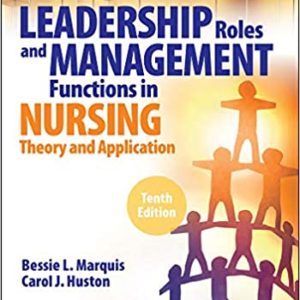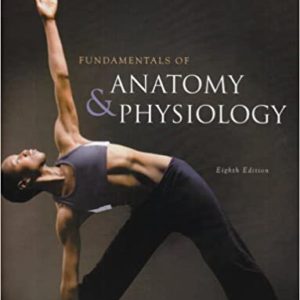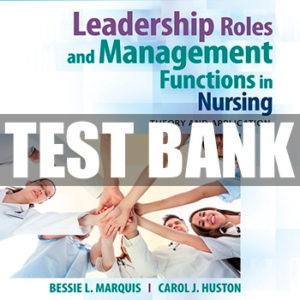TEST BANK FOR FUNDAMENTALS OF NURSING 9TH EDITION POTTER
$35
Description
Test Bank for Fundamentals of Nursing, 9th Edition, Patricia A. Potter, Anne Griffin Perry, Patricia Stockert, Amy Hall, ISBN-10: 0323327400, ISBN-13: 9780323327404
Table of Contents Unit I Foundations of Nursing Practice Chapter 1 Introduction to Nursing Chapter 2 Health of the Individual, Family, and Community Chapter 3 Cultural Diversity Chapter 4 Health and Illness Chapter 5 Theory, Research, and Evidence-based Practice Chapter 6 Values, Ethics, and Advocacy Chapter 7 Legal Implications of Nursing Unit II Community-Based Settings for Patient Care Chapter 8 Healthcare Delivery Systems Chapter 9 Continuity of Care Chapter 10 Home Healthcare Unit III The Nursing Process Chapter 11 Blended Skills and Critical Thinking Throughout the Nursing Process Chapter 12 Assessing Chapter 13 Diagnosing Chapter 14 Outcome Identification and Planning Chapter 15 Implementing Chapter 16 Evaluating Chapter 17 Documenting, Reporting, and Conferring Unit IV Promoting Health Across the Life Span Chapter 18 Developmental Concepts Chapter 19 Conception Through Young Adult Chapter 20 The Aging Adult Unit V Roles Basic to Nursing Care Chapter 21 Communicator Chapter 22 Teacher and Counselor Chapter 23 Leader and Manager Unit VI Actions Basic to Nursing Care Chapter 24 Vital Signs Chapter 25 Health Assessment Chapter 26 Safety, Security, and Emergency Preparedness Chapter 27 Asepsis and Infection Control Chapter 28 Complementary and Alternative Therapies Chapter 29 Medications Chapter 30 Perioperative Nursing Unit VII Promoting Healthy Psychosocial Responses Chapter 31 Self-Concept Chapter 32 Stress and Adaptation Chapter 33 Loss, Grief, and Dying Chapter 34 Sensory Stimulation Chapter 35 Sexuality Chapter 36 Spirituality Unit VIII Promoting Healthy Physiologic Responses Chapter 37 Hygiene Chapter 38 Skin Integrity and Wound Care Chapter 39 Activity Chapter 40 Rest and Sleep Chapter 41 Comfort Chapter 42 Nutrition Chapter 43 Urinary Elimination Chapter 44 Bowel Elimination Chapter 45 Oxygenation Chapter 46 Fluid, Electrolyte, and Acid Base Balance Appendix A: Equivalents Appendix B: Normal Adult Laboratory Values Appendix C: Canadian Nurses Association Standards for Nursing Practice
Chapter 01: Nursing Today
Potter et al.: Fundamentals of Nursing, 9th Edition
MULTIPLE CHOICE
1. Which nurse most likely kept records on sanitation techniques and the effects on health?
a. Florence Nightingale
b. Mary Nutting
c. Clara Barton
d. Lillian Wald
ANS: A
Nightingale was the first practicing nurse epidemiologist. Her statistical analyses connected poor
sanitation with cholera and dysentery. Mary Nutting, Clara Barton, and Lillian Wald came after
Nightingale, each contributing to the nursing profession in her own way. Mary Nutting was
instrumental in moving nursing education into universities. Clara Barton founded the American Red
Cross. Lillian Wald helped open the Henry Street Settlement.
DIF:Understand (comprehension)REF:5
OBJ: Discuss the influence of social, historical, political, and economic changes on nursing
practices. TOP: Evaluation MSC: Health Promotion and Maintenance
2. The nurse prescribes strategies and alternatives to attain expected outcome. Which standard of
nursing practice is the nurse following?
a. Assessment
b. Diagnosis
c. Planning
d. Implementation
ANS: C
In planning, the registered nurse develops a plan that prescribes strategies and alternatives to attain
expected outcomes. During assessment, the registered nurse collects comprehensive data pertinent
to the patient’s health and/or the situation. In diagnosis, the registered nurse analyzes the
assessment data to determine the diagnoses or issues. During implementation, the registered nurse
implements (carries out) the identified plan.
DIF:Understand (comprehension)REF:2
OBJ: Discuss the development of professional nursing roles. TOP: Planning
MSC:Management of Care
3. An experienced medical surgical nurse chooses to work in obstetrics. Which level of proficiency is the nurse upon initial transition to the obstetrical floor?
a. Novice
b. Proficient
c. Competent
d. Advanced beginner
ANS: A
A beginning nursing student or any nurse entering a situation in which there is no previous level of
experience (e.g., an experienced operating room nurse chooses to now practice in home health) is
an example of a novice nurse. A proficient nurse perceives a patient’s clinical situation as a whole, is
able to assess an entire situation, and can readily transfer knowledge gained from multiple previous
experiences to a situation. A competent nurse understands the organization and specific care
required by the type of patients (e.g., surgical, oncology, or orthopedic patients). This nurse is a
competent practitioner who is able to anticipate nursing care and establish long-range
goals. A nurse
who has had some level of experience with the situation is an advanced beginner. This experience
may only be observational in nature, but the nurse is able to identify meaningful aspects or principles
of nursing care.
4. A nurse assesses a patient’s fluid status and decides that the patient needs to drink more fluids.
The nurse then encourages the patient to drink more fluids. Which concept is the nurse
demonstrating?
a. Licensure
b. Autonomy
c. Certification
d. Accountability
ANS: B
You must be logged in to post a review.





Reviews
There are no reviews yet.